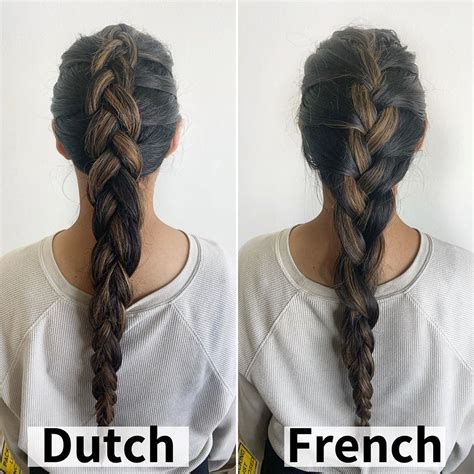Introduction
The art of braiding hair is an ancient practice that has been passed down through generations. From intricate cornrows to elegant chignons, braids come in a myriad of styles and forms. Among the most popular are the French braid and the Dutch braid, two techniques that share similarities but offer distinctly different looks.

Understanding the French Braid
Origin and History:
The French braid, also known as the “classical braid,” has its roots in Europe. It is believed to have originated in the 16th century and gained popularity during the French Revolution.
Technique:
- Divide your hair into three equal sections.
- Cross the right section over the middle section.
- Cross the left section over the new middle section.
- Repeat steps 2 and 3 until the end of your hair.
- Secure with a hairband.
Characteristics:
- Flat and tight against the scalp
- Intricate pattern created by interlocking strands
- Adds volume and texture to hair
Comprehending the Dutch Braid
Origin and History:
The Dutch braid, also called the “inside-out” braid, is thought to have originated in the Netherlands. It rose to prominence in the 19th century and has remained popular ever since.
Technique:
- Divide your hair into three equal sections.
- Cross the right section under the middle section.
- Cross the left section under the new middle section.
- Repeat steps 2 and 3 until the end of your hair.
- Secure with a hairband.
Characteristics:
- Bulky and raised from the scalp
- Loose and open weave creates a voluminous effect
- Adds texture and personality to hair
French vs. Dutch Braid: A Comparative Analysis
| Feature | French Braid | Dutch Braid |
|---|---|---|
| Appearance | Flat and tight | Bulky and raised |
| Technique | Cross sections over each other | Cross sections under each other |
| Difficulty | Moderate | Easy |
| Suitable Hair Types | All hair types | Thick, voluminous hair |
| Versatility | Can be worn in various styles | Best suited for loose, casual looks |
Benefits of French and Dutch Braids
French Braids:
- Create a polished and sophisticated look
- Keep hair neat and tidy
- Add volume and texture to fine hair
- Prevent hair damage by reducing tangles
- Protect hair from the elements
Dutch Braids:
- Add instant volume and fullness to hair
- Create a casual and chic style
- Conceal thin or damaged hair
- Can be used to create updos and other elaborate hairstyles
- Offer a stylish alternative to hats
Motivations for Choosing a French or Dutch Braid
French Braids:
- Desire for a formal and polished look
- Need to keep hair organized and out of the face
- Wanting to add volume and texture to hair
- Preventing hair breakage and damage
Dutch Braids:
- Desire for a casual and bohemian style
- Need to volumize thin or flat hair
- Concealing hair imperfections
- Experimenting with different hairstyles
- Creating statement updos
Pain Points to Consider
French Braids:
- Can be time-consuming and challenging to master
- May cause discomfort if braided too tightly
- Not suitable for all hair types, especially very fine or short hair
Dutch Braids:
- Can be more difficult to keep in place compared to French braids
- May lose volume over time if not secured properly
- Not as versatile as French braids for formal or elegant occasions
Tips and Tricks for Perfect French and Dutch Braids
French Braids:
- Start with damp hair for better hold
- Divide your sections evenly to create a balanced look
- Keep the tension consistent throughout the braid
- Practice regularly to improve your technique
- Use hairspray to set the braid in place
Dutch Braids:
- Begin with slightly dry hair to prevent slipping
- Pull the sections tightly under each other to create volume
- Use volumizing products to enhance the braid’s lift
- Secure the braid with bobby pins or hair clips for added stability
- Experiment with different thicknesses and textures to create unique styles
Common Mistakes to Avoid
French Braids:
- Crossing the sections too loosely, resulting in a sloppy braid
- Braiding too tightly, causing pain or hair breakage
- Not keeping the sections even, creating an uneven appearance
Dutch Braids:
- Crossing the sections too loosely, losing volume and structure
- Not pulling the sections tightly enough, resulting in a flat braid
- Not securing the braid properly, leading to loose strands
Beyond Beauty: Applications of French and Dutch Braids
Educational:
- Math puzzles can be created using braid patterns
- History lessons can be made interactive by exploring the origins of different braids
- Art classes can incorporate braids as a subject for study
Practical:
- Braids can be used to secure cords or cables
- Woven baskets can be constructed using braid techniques
- Jewelry and accessories can be embellished with braids
Health and Wellness:
- Braids can help relieve stress and promote relaxation
- Scalp massages can be enhanced by braiding the hair
- Protective hairstyles can be created using braids to prevent hair damage
Conclusion
French and Dutch braids are two classic braiding techniques that offer a wide range of styles and benefits. While French braids provide a sleek and sophisticated look, Dutch braids add volume and personality to hair. Understanding the differences between these two braids allows individuals to choose the best option for their specific needs and occasions. By embracing the versatility of French and Dutch braids, we unlock a world of creative expression, practical applications, and personal well-being.
